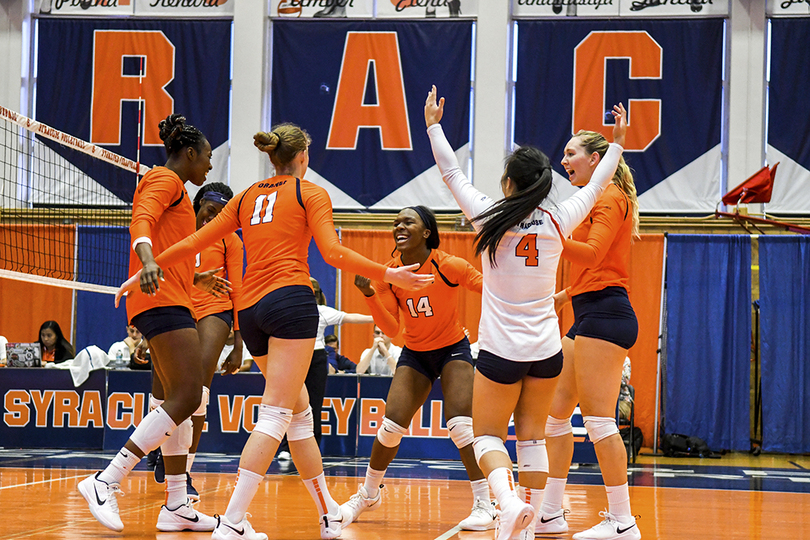Syracuse mixes up formations to keep opponents ‘on their toes’

Syracuse's differentiating formations help make sure that its opponents never stop adjusting. TJ Shaw | Staff Photographer
When starting setter Jalissa Trotter suffered an injury early last season, Syracuse heavily utilized a 5-1 formation, in which five players are hitters and only one acts as a setter. Upon her return, the Orange switched back to using more of their 6-2 formation, where all six players can hit and two also act as setters.
This season, currently at full-strength, SU (8-4, 4-0 Atlantic Coast) SU alternates between the two, helping the Orange through their current five game win streak that includes starting 4-0 in ACC play.
“I think switching back from the 5-1 and 6-2 is something that can also keep teams on their toes where they have to worry, ‘Oh, they’re going from here to here to here, so we have to be prepared for it,’” Trotter said. “So if they think we’re running the 6-2 they have to prepare, and if we switch mid-game and they’re like, ‘Oh, we didn’t go over this’ or ‘How do we change?’”
The 5-1 formation is considered to be the standard in volleyball as each player only has one responsibility and with one setter, one player runs the offense. When Trotter is in the 5-1, however, she stays on the court the whole time and doesn’t get a chance to sub out and take a “mental break.”
The 6-2 formation allows for more substitutions as the setters typically play three rotations and then sub out. The system is both offensive and defensive, associate head coach Erin Little said. Every player can hit, but there are also two players who can set. A 6-2 formation also allows for a setter in both the front and back rows, normally playing opposite each other on SU’s side of the court.
“Really it’s based on what’s going to make us the best team that night,” Little said. “So whether that is based on injuries or who’s performing well, we want to put those players that are performing well on the floor.”
This year Syracuse has a lot of options to choose from, making switches between formations easier, Trotter said. Ten players have played 28 or more sets this season. On the offensive side, seven players have more than 40 points.
Trotter has remained the main setter, accounting for a team high 397 assists. Elena Karakasi is the only other player in triple digits, with 145.
“We have a really strong team this year,” SU libero Aliah Bowllan said. “I’d say every player, whether they’re on the bench or on the court is pretty equal, it’s just figuring out what six players gel the best.”
Most teams SU plays usually commit to one system or the other, Little said. However, some teams switch throughout the season or, like Syracuse, will do so in-game. To prepare for how other teams will play, the Orange normally watch tape from at least three of their upcoming opponent’s most recent games.
The different formations can “keep teams on their toes,” Trotter said. But SU knows not all opponents will be flustered, just as the Orange try not to be affected by other team’s formations.
“I think you want to focus on your team first, what are your strengths and making sure you’re not changing your strengths all the time based on what someone else is doing,” Little said.
What Syracuse runs all depends on the situation, both Trotter and Bowllan said. If an opponent is shorter, for example, Trotter said running a 6-2 can be more effective with three or four hitters up all the time. Sometimes, a 5-1 is better so that middle hitters have an open lane to run plays behind the setter, making slide hits easier.
But often the formation being used is simply whichever plays to the Syracuse players’ strengths.
“We want to put the players that can help us on the floor,” Little said. “If that means bringing in somebody to serve, if that’s defensively, if that’s adding a hitter or a blocker, whatever will make us the best team, we want to put them on the floor. It kind of forms into the systems we’ll play.”





